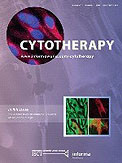Forostyak S, Jendelova P, Kapcalova M, Arboleda D, Sykova E. Cytotherapy. 2011 Oct;13(9):1036–46. Epub 2011 Jul 8. IF: 2,925

Abstract
BACKGROUND AIMS: Amyotrophic lateral sclerosis (ALS) is a progressive neurodegenerative disorder characterized by the loss of brain and spinal cord motor neurons (MN). The intraspinal and systemic grafting of mesenchymal stromal cells (MSC) was used to treat symptomatic transgenic rats overexpressing human superoxide dismutase 1 (SOD1) in order to alleviate the disease course and prolong the animals' lifespan. METHODS: At the age of 16 weeks (disease onset) the rats received two grafts of MSC expressing green fluorescent protein (GFP(+) MSC) on the same day, intraspinally (105 cells) and intravenously (2 × 106 cells). Sham-treated animals were injected with phosphate-buffered saline (PBS). Motor activity, grip strength and body weight were tested, followed by immunohistochemical analysis. RESULTS: The combined grafting of MSC into symptomatic rats had a significant effect on motor activity and grip strength starting 4 weeks after transplantation. The lifespan of animals in the treated group was 190 &pkusmn; 3.33 days compared with 179 &pkusmn; 3.6 days in the control group of animals. Treated rats had a larger number of MN at the thoracic and lumbar levels; these MN were of larger size, and the intensity of terminal deoxynucleotidyltransferase-mediated dUTP-biotin nick-end labeling (TUNEL) staining in the somas of apoptotic MN at the thoracic level was much lower than in sham-treated animals. Transplanted GFP(+) MSC survived in the spinal cord until the end stage of the disease and migrated both rostrally and caudally from the injection site. CONCLUSIONS: Intraspinal and intravenous transplantation of MSC has a beneficial and possibly synergistic effect on the lifespan of ALS animals.
